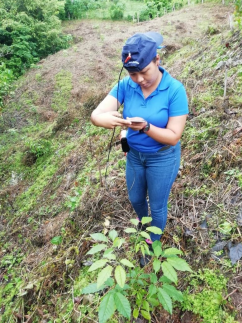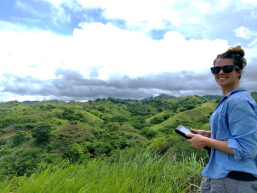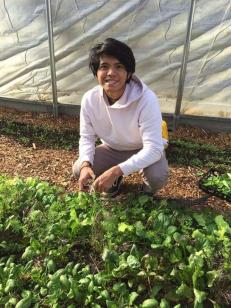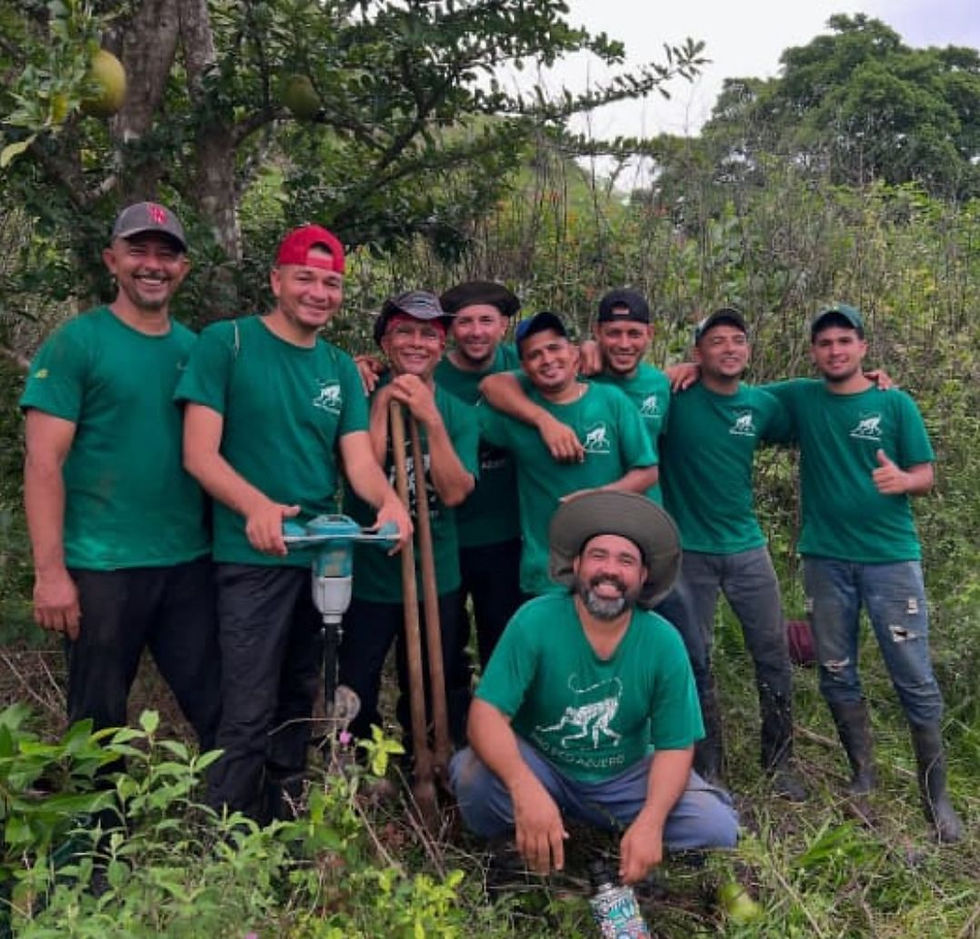The Farmer’s Perspective: A Series of Interviews with Sociological Research Workers for FPEA
- Jul 27, 2020
- 9 min read
Sure, you can look up images of places, people, and things. You can read articles, stories, and statistics. But there is really nothing like physically being there - like the thrill of skydiving, actually seeing Everest with your own eyes, or having a conversation with your celebrity. The experience is firsthand, and there is a whole other dimension of information to be acquired from being there. In regards to the farmers in the Azuero peninsula, this idea applies as well. To fully understand the way the farmer perceives reforestation and his/her land, there is nothing quite like actually talking to them in their home environment.
I personally had not known the difference between reforestation, natural regeneration, and assisted natural regeneration before conducting interviews with individuals who have worked with Fundacion Pro Eco Azuero on this project/publication. However, if I do say so myself, this could be excused based on my suburban upbringing, quite different than. What can be said about rural farmers located throughout the Azuero peninsula of Panama, who have had years of experience growing up in the land, surrounded by forests?
These past couple of weeks, I spent some time interviewing three important individuals who have participated in a study regarding the farmer’s perceptions of these different reforestation strategies: active reforestation, natural regeneration, and assisted natural regeneration. They have shed light as to what distinguishes these strategies, as well as some insight as to the farmers’ perceptions of these strategies; furthermore, their statements can implicate a further importance of local landowners in the overall objective of reforestation and environmental conservation. By learning more about the farmer’s perception regarding reforestation strategies, we can better understand how to best help the overall goal of forest conservation, since they are individuals who frequently come into contact with the trees and land of interest.
To begin with, I conducted an interview with Vicente Vasquez, a current undergraduate student. He is someone who has participated in helping this study, particularly in the sociological aspect of survey and analysis. Here are his definitions:
“Reforestation is more active, and tends to be more expensive...it involves strategic planting of trees”.
“Natural regeneration is basically letting [trees] live to grow by [themselves], and assisted natural regeneration involves more work, including fencing and monitoring of the [reforested trees]”.
Fair to say, one can understand why the common layman wouldn’t know these off the top of their head.
The second individual that I interviewed was Cristina Barber Alvarez-Buylla from Spain, a pHD student at Boise State University. Her pHD work has a main focus on ecological modeling, generally trying to describe an equation/algorithm that can describe and predict where forests will optimally grow back in large areas through analysis of field data like high resolution satellite imaging. She works with large scales of areas, leading to thousands of hectares, and her
work, upon completion, could have significant implications for land management in the future. She helped construct the survey, as well as analyze the results.
Vicente and Cristina mainly worked on the sociological aspect of this endeavor to understand more about the farmer’s perception towards such reforesting strategies; specifically speaking, the questions they wanted to tackle included: How did the farmers define the different strategies, and what do they relate these strategies to? What are their preferences, and what could be some drivers of said preference?
Now, what better way to tackle these questions then to ask the farmers themselves? Thus, Vicente explains that they “developed the survey and put together a team of researchers”, designed to conduct personal interviews through a semi-structured survey with about 20 questions. The general plan was to find local farmers as subjects for these interviews, then use the snowball method to branch out to expand the interviewee pool.
The last and third individual is named Roxana Garcia, a former volunteer and now employee of Fundacion Pro Eco Azuero, who specifically took on the physical visitation aspect of the survey outreach “from house to house”. She details her firsthand experience in the actual farms as an “arduous job, walking door to door, in the rain or in the sun”, in order to “get the answers that were needed”.
For the survey process, Cristina explains that they randomly selected farmers from a list of farmers from MIDA; they then paid a visit to these local landowners and conducted the interviews. According to Roxana, these questions included asking about “the farmer’s previous reforesting experience” and “how many hectares were on their farm land”, as well as their previous knowledge on reforestation as a topic. “Many farmers were open to answering these questions, but we met several people who did not display any interest or seemed confused, to the point that it was up to us as collaborators to speak to them in a simpler way to make their understanding easier,” Roxana describes.
Upon the finalizations of their responses, Vicente and the team concluded that there were about 64 surveys worth analyzing - some were omitted due to missing data and were not deemed fit for further analysis. He explained that he and his contributors “considered variables such as parcel size, the area of their land that had been/was already reforested, and the location as possible drivers of preference”.
Now what were the findings?
“Overall, the most preferred option was cleaning the parcel for cattle.”
According to Vicente, about 40% of the interviewed farmers chose their primary preference as taking out every single tree and using that space for cattle ranching - they preferred no reforestation, either active or passive. Vicente speculates that “this preference was mostly based on economic benefit, since cattle ranching has obvious profit benefits”. However, there is a catch. An equal amount, about 40% of farmers, chose cattle farming as their last preference - in other words, there was about the same amount of people who were actively against the nature of cattle ranching. This highlights a polarized nature between the farmers of Azuero.
There is a special social nuance in the peninsula - an intermingling of prevalent traditional hawks that will have no nonsense regarding change, and a rising, more juvenile, troupe of reforestation advocates who see the benefits. This has made itself evident in the relatively even divide and distribution of preference.
Additionally, Cristina discusses some examples of drivers of preference among the farmers: “The bigger the farm size, the less likely they are to clear the land and allow natural regeneration”. For the preferences, Cristina explains the usage of a regression model where the order of preference is taken into account and quantified. Vicente also adds that the publication process of their research took a considerable amount of time due to the tasks of eliminating outliers, analyzing the quality of the data, and quantifying the preferences by using a base for comparison purposes.
“It’s just a matter of experience to reforestation exposure”, Vicente says. “The past two decades have had increased exposure to the benefits of reforestation, leading to a growing population of supporters”, he adds. However, the presence of power-holding patriarchs who are firm believers of cattle ranching have stunted the true growth of these new reforestation supporters. But while these local authoritative presences exist, this is not to say that there hasn’t been any change; Vicente notes that there have been farmers who have agreed to allow change on their lands, to allow for the growth of more trees, upon seeing and learning the benefits not only for them, but for the earth as well.
“It doesn’t matter that the land has the capacity of growing if the people that own it don’t want growth or won’t consider it [for reforestation”, Cristina interjects. The concept of privately owned lands is one of the biggest institutional barriers to progress, in her eyes. When people do not see eye to eye, it has proven to be tough to try and change their outlook on their private property.
The second overall preference was natural regeneration and reforestation, according to Vicente and Cristina. However, “they did not understand the difference between natural regeneration versus active regeneration”, and so this misunderstanding was apparent, yet difficult to maneuver during data analysis. Vicente mentioned the linguistic barrier; “the slang terms in the Panamanian language don’t necessarily match with the literature review terms used in ecological papers and studies”; he accentuated that this contributed to misunderstandings, such as the confusion between active reforestation versus passive reforestation. Thus, this could explain why natural regeneration and reforestation were both grouped together and second in overall preference.
Cristina confirms the existence of these comprehensive barriers: firstly, “there hasn’t been lots of research on the farmer’s perception of the land” which likely explains the reason how they “didn’t understand natural regeneration as a reforestation strategy”, or “as a way to increase the benefit from the land”. She adds, “One of the main things that we have to do to make sure that we find a way of understanding each other and see how we can work with the farmers to find a common understanding on natural regeneration and learn from them”.
“When you think about a project, you think that you have to do something - you don’t think about letting it grow without doing anything”, Vicente adds. This mentality is what he attributes to a potential reason for the misunderstanding of natural regeneration as an extensive ordeal as opposed to a laissez-faire approach to letting nature take over. “This can be combated with experience and education,” he concludes. “There is a positive reaction in general to most farmers when they feel they are a part of it...when you allow them to think that the land has a place to preserve their heritage”, he adds. He emphasizes the importance of the land as a symbol of heritage and tradition to the local farmers, and he points to catering to this idea as a way to accelerate the desired tweaking of social/cultural norms. Cristina agrees that “getting more into the farmer’s definition of natural regeneration and reforestation” would be best, through “bottom-up studies”. Thus, rather than impersonal projects with a top-to-bottom nature, more personalized reforestation projects that speak and engage with the landowner would likely have greater success in terms of impact.
Of course, this is easier said than done. Interestingly, Cristina explains one example of a social norm that opposes their objectives: the concept of “dirty land” motivates farmers to clear their land, since they view forested areas as obstructions, as if it needs to be “cleaned” to clear the area for grass for grazing. Natural regeneration inherently rejects this idea of “dirty land”, and does not allow the farmer to choose what is going to grow on their land, both of which can be deterrents from the landowner’s participation.
However, credit is due where it is due. These farmers have a lot of traditional knowledge on their farms, and they understand how the river flows based on trees, and they sense the value of simple shade for their cattle when they see all their cattle huddling underneath one tree. They appreciate trees from a fundamental standpoint, but this is overshadowed by the seemingly more profitable option of clearing the land. Cristina adds that appealing to such fundamental understanding/respect that these farmers have towards the land could be a great launching point for selling the pitch of reforestation.
“With time, they will realize that the land will stop being productive at some point”, she implies. Thus, she highlights the educational initiatives run by Fundacion Pro Eco Azuero, indicating that initiating change from loved ones, from the youth, is a long-term, effective strategy for combating the consequences for when this realization will make itself evident in a visible manner.
When talking about future research avenues, Vicente drove in the point regarding experiential research: in other words, living more with the farmer, trying to find patterns of behavior and ideology to see how they manage their land from an insider’s point of view. Instead of only surveys and interviews, the goal would be to try and to experience what they do in their land, and thus eliminating any and all superficiality. Through the surveys, a significant amount of information has been gathered that has proven to be valuable in providing insight. For example, they were able to uncover that the farmers perceive assisted natural regeneration negatively on the basis that because fencing and monitoring costs money, it is economically unfavorable. This provides information that they do not understand the labor costs that assisted natural regeneration avoids, and the overall cheaper option that ANR provides. However, perhaps with further experiential research of studying the day to day interactions, one could ascertain and probe more deeply into whether their attitudes can be changed.
When asked the question ‘Why is it important to include local owners in these studies?’, Roxana replied, “It is important why they are the day-to-day ones on their farms since they have more general knowledge”. In other words, regardless of their reforestation preference, it can’t be denied that they know a lot about environmental issues in the field, in their home. Local landowners are the protagonists; as Cristina mentioned before, the domain that which we are trying to reforest and conserve is privately owned, and so they must be the focus of our intent - they are the key. Appealing to them, talking to them, and learning about their perspectives is the essence of sociological targeting.
In conclusion, Vicente summarizes, “People don’t really know the difference, but people are looking for an alternative. They appreciate trees, but they haven’t been around for techniques and projects, and so there is not enough exposure. There have been about two hundred years of cultural norms of cutting trees since colonization, so it can be an uphill battle, but “progress is being made”.













Comments